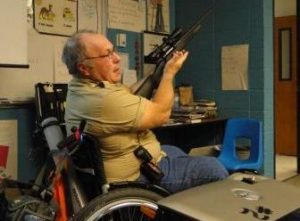Menu
 Dennis, back in the classroom, where he teaches a Hunter Education class at a middle school in Billings, Montana.
Dennis, back in the classroom, where he teaches a Hunter Education class at a middle school in Billings, Montana.An avid hunter, Dennis Hein, 56, enjoyed getting outdoors in Billings, Montana. For several years, he shared his enthusiasm for hunting by teaching a Hunter Education class in one of the local middle schools. But, a couple of years ago, nerve damage affected Dennis’s ability to walk, causing him to need a wheelchair and to cut back on his time spent outdoors on trails and at the shooting range.
Last year, Dennis couldn’t teach the Hunter Education class because he couldn’t make it up the school’s access ramp in his old wheelchair, nor could he get his old wheelchair’s front wheels over the threshold. At the shooting range, he couldn’t sit in his wheelchair while shooting for fear of tipping over. Even when seated on a bench, he worried about losing his balance from his rifle’s recoil.
This year, things have changed. Shooting while seated in his RoughRider®, Dennis is more confident, knowing that his chair is stable and won’t tip over sideways. And, he’s once again teaching his Hunter Education class and going to the shooting range. “The chair just makes getting around a whole lot easier. I can get around in tight spaces easier and get over the rough spots much easier. I even attempted to go up a mountain bike path that I would not have attempted in my old chair.” Dennis is also thrilled that he can once again enjoy watching his granddaughters play softball and volleyball.
To find the distance between your hips, first position yourself seated with pelvis upright on a firm surface. Then, measure the distance between the widest points of the hips and thighs without compressing any tissue. Finally, record your measurements. It is important not to have a chair that is wider than necessary as it will be harder to push and may prevent you from passing through narrow doorways.
Position yourself seated upright on a firm surface. Measure the length of your upper leg, the distance from behind the knee to the back of the pelvis (back of your lower leg). Subtract 1/2” to find the maximum seat depth, to allow for space between the back of the knee/upper leg and seat fabric. Record the final measurement.
Your preferred backrest height is determined by your personal comfort level and physical ability. Whirlwind recommends, generally, that the top of the back support should fall just beneath the bottom of the shoulder blade. For less active riders who require more torso support, the back support should be higher, falling just beneath the armpit. Position yourself seated upright on a firm surface. Hold your hands flat against the surface you are sitting on. Measure the distance from the seated surface to the desired, most comfortable point for support on your back. To this number add the height of your cushion when you are sitting on it. Record the measurement.
Backrest angles are determined by the torso control of the rider. Whirlwind recommends that those with less torso control, such as quadriplegics, sit with a backrest angled further backwards to avoid falling forward in a wheelchair. Those with more torso control, such as amputees, can sit with the backrest more upright. Proper backrest angle is best determined by an occupational therapist or healthcare professional. Although there is only one option – 8 degrees – in the drop-down list below, you can adjust the backrest angle by adjusting the backrest straps (i.e. looser at the bottom and tighter at the top for a more erect position).
Now please enter your measurements into the fields on the product page before ordering. For more information about measuring, please refer to the RoughRider Fitting Sheet. You are responsible for choosing the right chair for yourself. If you are uncomfortable with determining your wheelchair size, please consult a professional.